|
Way back in 1975, my friend, Jerry Flynn, and I assisted Dick Weber in his successful
flight on June 14, 1975, that set a new FAI Closed Course Record of 225 miles in 5 hours
and 38 minutes. We were both flaggers to signal when the Tortoise has passed the distance
markers. See the article titled, "652 Miles Per Gallon," in
the November 1975 issue of Model Aviation magazine. We were not at all
involved in all the painstaking effort that Dick had put into preparing his model for
the record flight. This account of William Bertrand's trials and tribulations in
finally setting a new radio control world endurance record is valuable insight into
what it can take to achieve such a goal. test after test on engines, fuel, airframe,
radio system, fuel tanks, fuel feed systems, and other minute details would likely
frustrate most people to the point of abandoning the effort, but it is persistence
and good nature that keeps people like William and Dick going.
Eleven Hours of Luck - Record Breaking Mystic
William F. Bertrand
The endurance mission presents the greatest design problems by far.
How the world's RC record was broken holds interest for all of us.
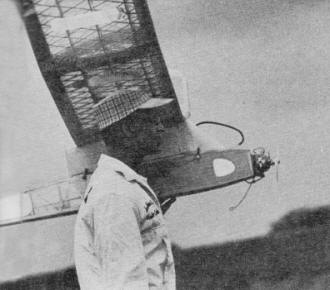
A proud man with the smile of success. Note reflectors located for
extra visibility.
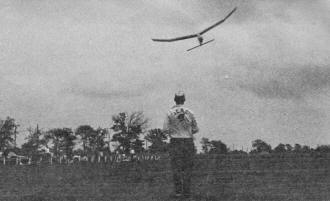
Near the end of the flight, the Mystic makes a low pass. Many Indian
City RC members helped with attempt.
At one time or another, I think we all read about somebody setting a record and say
to ourselves, "I think I'll take a crack at the record!" This happened to me several
times before I ever got beyond the stage of talking it over with friends. When Bob Dunham
broke the speed record, I started sketching designs. The final urge came in the spring
of 1966 when Red Gunning, who had been working on the endurance record for some time,
asked Bill Laubengayer and me to act as timers. He had to land after six hours with radio
trouble, but when I watched Red, I thought this shouldn't be too hard.
I should try instead of just thinking and talking about it. Then Red threw in the
final challenge, "Why don't you try it?" I couldn't resist any more; I would start my
ship when I got back from the Nationals. I looked at Red's design, got all the info I
could from him, and started to give the design of my ship some serious thought. I finally
got started in Sept., 1966.
I needed a ship that would carry a maximum payload with a minimum of power. Since
the radio was a constant weight regardless of ship size, I decided the bigger the ship,
the less percentage of load the radio would be. The FAI rules allow 2325 sq. in.; I decided
to go with 2300 sq. in. to stay within the safe limit. The next problem was power. How
small an engine could I fly with this monster? I thought maybe a .19, but probably a
.25 or .29, depending on how light I could build the ship. I started the design using
every trick I knew to keep it light and came up with a couple of new ones along the way.
The fuselage was built with a triangular section behind the wing, because it saved
the weight of one piece of quarter square 36" long. The fuselage cross section was kept
to a minimum because this meant less wood, silk and dope. All wood was selected with
light weight being the prime concern. At this point, the fuselage was constructed and
turned out very well at 4 1/2 ounces without covering.
The wing was next. A thick Clark Y-section was chosen for its high lift and tolerance
to changes in the center of gravity which might be encountered with fuel sloshing in
the tanks. After much thought, it was decided to use geodetic construction. By this method,
a wing could be built much stronger than any conventional wing. The wing looked very
difficult to build, but once started, I was amazed at how simple a project it was.
There are three spars in the wing: On the inboard sections they are made up of two
1/4" squares with 1/4 x 1/8" cross-members. On the outboard sections, the spars are made
of two pieces of 3/16" sq. with 3/16 x 3/32" cross-members. The leading edge is made
of 1/16" sheet rolled into a 1 1/4" tube with 1/4" thick styrofoam plugs every 3" for
compression strength. The trailing edge is conventional 1/16" sheet, top and bottom.
The geodetic structure is made of 3/16 x 1/16" on the center sections and 1/8 x 1/16"
on the outer sections. With these methods, the wing weighed only 22 ozs. uncovered and
would take three G's on an 11-lb. airplane before it was even covered. This would likely
double with covering, but I didn't have the guts to try it after it was covered. This
point was pretty well proven later, when on a landing, the plane flipped over with a
full load of fuel and remained undamaged.
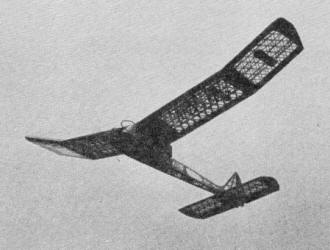
Skin and bones in flight. Bill removed all the color and adhesive
from the MonoKote where it does not touch the frame. Less weight. Structure stained by
RIT dye aided visibility.
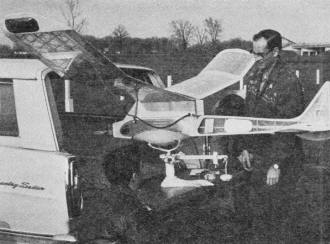
Weight and wing and tail area are limited by FAI rules to 11 lbs.
and 2,325 sq. in. Note how the tank fairs into the fuselage shape. Proper tank design
and fuel delivery system all-important.
The stab uses a symmetrical section and was made with a single spar built up of two
pieces of 1/4 x 1/8" with 1/4 x 1/8" cross-members. The leading and trailing edge are
1/4" sq., with the geodetic structure being 1/8 x1/16". The completed stab weighed only
3 ozs. without covering.
The entire model was covered with yellow MonoKote, because it has a good durable finish
without more weight than lightly doped silk. This weight was then drastically reduced
by removing the color from the MonoKote everywhere except around the edges of each panel.
It was necessary to leave this, as the color is also the glue that holds the MonoKote.
I also felt that I needed some color to make the ship easier to see at high altitudes.
Visibility was further improved by spraying the entire structure with red dye dissolved
into thinner. The dye was Rit clothes dye (I used one package dissolved into a pint of
thinner). The package of dye weighs about 1/2 oz. and thinner completely evaporates.
If it all went on the plane, I would add only 1/2 oz. About 95% of the spray went on
my basement floor. Reweighing after a couple days, I could not detect any increase in
weight over the undyed structure.
I now had a ship complete, less radio, servos, engine and tank, that weighed only
1 lb. 13 1/2 oz.; it looked like I could make the minimum weight. Decided to use a Min-X
reed-type radio, as it has several advantages for this kind of flying. One of these was
its superior interference immunity, due to the sharp selectivity of the reeds themselves.
Another is the low battery drain on the receiver and servos when no command is called
for. To help keep the battery drain as low as possible, I used very wide neutrals on
the elevator and rudder. This was done by applying small strips of MonoKote to the ends
of the printed-circuit return switches of the Controlaire servos. I used half the rudder
travel as trim, and the elevator was trim from half way up to full down. This system
allowed the whole flight to be made with only an occasional short beep on the transmitter;
the servo motor having to move only a couple of revolutions.
I followed Red's lead on the batteries and used Burgess Alkaline type energizer cells.
In addition to this, I sat in the basement watching TV for many an hour running tests
just to assure myself the batteries were adequate.
The engine was the real problem now. I started running tests on everything I had and
found nothing significant until I came to an old Enya diesel. This engine would swing
a 14-6 prop 3,750 rpm on only 4 ozs. of fuel per hour on the ground. Later, this jumped
to about 5 1/2 ozs. in the air. The engine worked well, but refused to throttle almost
entirely. I decided to go with the Enya, and let it run full bore.
An important element in the success of the attempt was the reliable Super Tigre .15
RC diesel, which turned the 12-6 prop powerfully and had a steady slow idle.
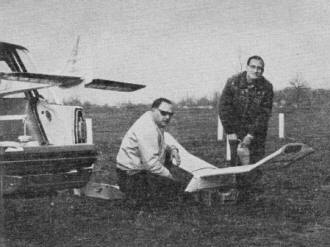
The fuel system between he main tank and the engine has a header tank
with cork float and valve. It's simple and effective.
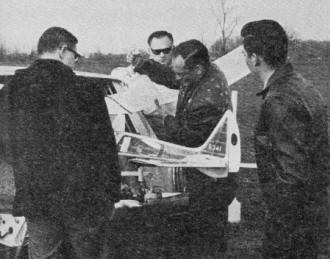
Fueling the Mystic with three quarts of diesel fuel - 20% Ucon oil,
40% ether, and 40% kerosene.
The next problem was a float chamber. I tried several different designs without making
one work to my satisfaction unless it was too large or too heavy. The final design turned
out to be simple and light. It was made from a cut-down 6 oz. plastic bottle for the
reservoir with a metal lid that would just fit the inside diameter of the bottle. The
lid was held in by three screws around the outside edge. Through the center of the lid,
was soldered a piece of 1/8" brass tubing extending :1/2" inside and 1" outside. This
tube had 3/4" piece of neoprene tubing attached on the inside. The float was a cork with
a piece of .032 music wire stuck in the top. This rode inside the brass tubing and a
blob of solder on the wire would close off the neoprene tubing when the float reached
the proper level.
The first test flight was made on Oct. 16, 1966, with just an 8-oz. clunk tank stuck
in between the rubber bands on top of the wing. The ship handled like a dream, but didn't
prove anything, as it weighed only 4 lbs. 2 oz. at this point. The Enya with a 14-6 would
take the ship up to about 4000' in less than a half hour.
The following Wednesday, Red called me and said he and Gordon Pearson were going to
make an attempt on the next Saturday; could I make it? I told him I would try. I still
didn't have a tank and didn't have time to experiment with a plastic for vacuum forming
that would hold up in the fuel or even find out if I could get off with a full load of
fuel. I switched to a K&B .45, as I knew this would have the power to get the ship
up there. For a tank, I would use a plastic gallon fuel jug strapped on top of the wing.
I had to have some new fuel, and I knew nothing about fuels. I went back and reread Maynard
Hill's article; decided to try his mixture. It worked so well, I was amazed. I ran tests
in my garage (to keep the noise down) on the engine Wednesday and Thursday nights. Friday
night, I flew two hours with the K&B .45 and gas mix; it worked. I called Red that
night and we agreed to try for a 6 a.m. takeoff.
Saturday, Oct. 22, I was up at 4 a.m. calling my crew: Paul Secan, Bill Laubengayer
and Al Olada. By 5:30 we were at the field. Red was delayed until 7:00. We couldn't do
anything until he got there, as he had the scales to weigh in with.
Red and Gordon were in the air in short order. They had followed my lead and installed
diesels in their ships while I had gone backward, and was using glow. After weighing,
fueling, and reweighing, I tried to start the K&B only to find my starting battery
dead. We tapped one cell on the car battery and got started. Everything seemed all right
and the .45 pulled the ship with a full gallon of fuel like a skyrocket. I let it climb
to about 1,000' and throttle back - then the trouble started. The engine started to get
rich and the ship started down; high throttled again, and it didn't help. The wind was
now gusting about 15 mph and on landing, the wind caught the Mystic and turned it upside
down. We all thought that the wing had had it. The geodetic construction paid off, as
she just bounced on the wing like a rubber ball. Upon inspection, we found only a couple
of spar cross-members knocked loose.
Why had the engine suddenly gone so rich? A hurried job on a fuel filter had been
done the night before. This had been sealed with Selastic rubber, which didn't have sufficient
time to cure. A strip of this rubber had gone down into the float chamber and caused
it to stick, flooding the engine.
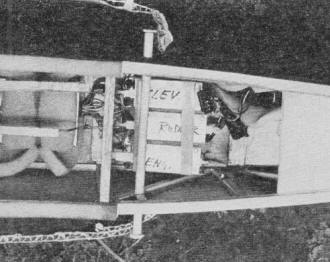
Min-X reed system with very wide neutral Controlaire servos for minimum
battery drain and maximum interference resistance.
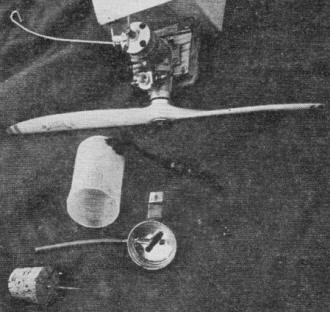
The tank is the bulky thing below the wing. It is made up of balsa
and brass. All fueled up, the plane weighed 11 pounds at takeoff.
The float chamber was cleaned, filter removed, ship refueled and reweighed for another
attempt. Now the engine would not keep running. I added propylene oxide to the fuel to
help the ignition. This worked, only now the K&B was running too hot from lack of
oil. One thing led to another and pretty soon it was too late to make an attempt; it
would be dark before the record could be broken.
Both Red and Gordon were having trouble with their engines and had to come down after
an hour or two on several different attempts.
During the winter, I built a tank of balsa that would attach to the wing. It looked
like a cabin sitting between the wing and fuselage. The tank was lined with drafting
vellum and coated with epoxy. This tank would hold a gallon of fuel and added only 3
oz. to the weight. About this time, I was able to obtain a Super Tigre .15 RC diesel
and tests showed it would turn 4,000 rpm on the 14-6 at almost the same fuel consumption
as the Enya. This extra rpm would help on the takeoff and the Tigre throttled down to
about 1,000 rpm without ever missing a beat. I couldn't have asked for more.
I started to experiment with diesel fuel and tried many different combinations before
coming up with the final mix. This fuel was 20% Ucon oil, 40% ether and 40% kerosene.
I used the Ucon oil instead of castor oil because it does burn; this, in a small way,
contributes to the power and makes for a cleaner ship. I think a good, clean, all-around
diesel fuel would be 25% Ucon 37-1/2% ether, 37-1/2% kerosene.
Now everything was ready. All we had to do was wait for spring and good weather. In
April, I made a test flight and everything went fine. On the test flight, I used an 8-oz.
plastic tank tied on top of the wing, in order to keep the main tank clean. We had set
April 22nd as our first attempt, but had to cancel as the wind was up to about 25 mph;
much too high for a ship of this type.
The next attempt was set for May 6. On the Wednesday before, I decided to try the
ship with a full load. I still flew using the 8-oz. tank above the wing, but filled the
main tank with water. This was intended to keep the tank clean and would weigh about
a pound more than the fuel. The water kept the tank clean, along with the radio and servos.
After an hour flight, I brought the Mystic down and found the tank had leaked. There
was a half inch of water in the fuselage and the receiver was half covered. I still find
it hard to believe that the receiver was still working; maybe I should try a submarine.
I was convinced the extra few ounces for a brass tank were well worth the safety of
not having a repeat of that flood. A brass liner was made and installed inside the wooden
structure at a cost of 4 ozs.
On Saturday, May 6, we were all at the field at 6 a.m. The plane was weighed, fueled,
reweighed and in the air at about 7:30. The flight ended after seven hrs. 59 mins. I
had spiraled down from about 4,000', and the engine quit about ten minutes later. It
was assumed that the fuel feedline had lost its prime, as fuel went to the front during
the spiral, and the fuel line to the float chamber was high in the front of the fuselage.
A new feedline was made so that I was sure flow was downhill all the way.
On Saturday, May 13, 1967, I was up again at 4:30 a.m. calling the crew. We were at
the field at 5:45 weighing in; the empty weight was 5 lbs. even. I decided to carry the
same fuel as the week before (3 quarts), because I had had a quart left in the tank after
eight hrs. The fuel consumption goes down as the ship gets lighter, requiring less power.
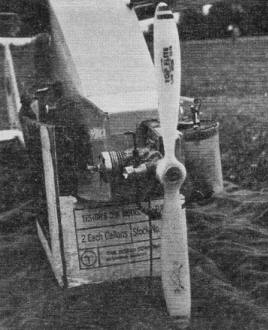
An important element in the success of the attempt was the reliable
Super Tigre .15 RC diesel, which turned the 12-6 prop powerfully and had a steady slow
idle.
I hand launched the Mystic at 6:21 a.m. The Super Tigre was turning a 12-6 at 6,000
rpm and she climbed out beautifully at 10 lbs. 2 oz. The sun was shining, and the sky
was full of small clouds at about 10,000'. This meant a lot of thermal activity when
it got a little warmer. After about five minutes, I had to throttle back as the ship
was already getting too high. About 9 a.m., the sky started to clear; by 10, there wasn't
a cloud in the sky. I couldn't have had a better day, as this meant I wouldn't have to
fight the up and down drafts. I could relax on the chaise lounge and occasionally make
a correction. About 11 o'clock I wanted more down trim and found I was already in full
down. At this point, I assumed the elevator had slipped out of the saddle; but after
the flight was over, we found I just didn't have enough down elevator. This problem never
amounted to anything, as the wind never got up to more than about 10 to 12 mph; but it
could have been a real problem.
I can't say that anything else unusual happened on the whole flight. She just flew
and flew until at about 5:34 p.m., the Super Tigre ran out of fuel. The airplane was
about 200' in the air. I made one pass down the field; turned around and landed. The
touchdown was at 5:38 (only 16' from the point of the takeoff) 11 hrs. 17 min. and 47
seconds later. (I'll bet I get more flying time in one day then a lot of you fellows
do in a month.) Upon examining the ship, a pint of fuel still remained: enough for at
least another couple of hours. The fuel filter was plugged, causing the engine to quit.
All the equipment used was strictly stock. The only changes being that of adding MonoKote
to the servos to make them have broad neutrals. The Min-X was a set that had been used
for several years, prior to being installed in my ship.
I wish to take this opportunity to thank my wife (Shirley), Red Gunning, Paul Secan,
Bill Laubengayer, Clyde Atkinson, Jack Steele, Don Gaskell, Tom Bell, Tom Byrnes, Maynard
Hill, The Indian City Radio Control Club, Min-X, Super Tigre, Controlaire, Top Flite,
Sig and many others who in some way contributed to my being able to set this record.
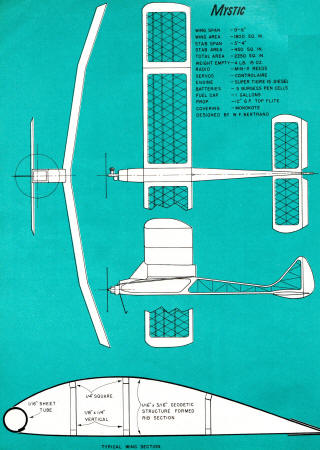
Mystic Radio Control Model Airplane Plans
Posted November 17, 2018
|